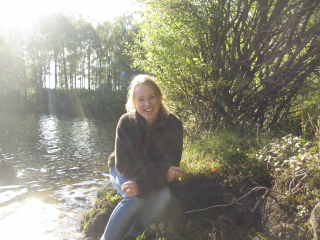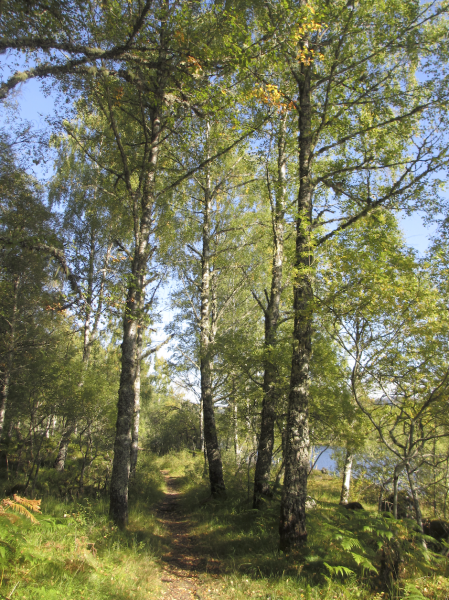Category: Volunteer Voice
Long-Term Volunteer Emily Warner reflects on her first month spent helping to restore the Caledonian Forest, explaining why Dundreggan is such an inspiring place to be and how the work done here is having such a positive impact…
 This last month, my first as a Long-Term Volunteer (LTV), has gone past incredibly quickly. The combination of such action packed days, where we have been presented with an ever changing array of different tasks, and free time spent in such beautiful surroundings has meant that there has not been time for a single idle moment or a chance to wonder what to do next!
This last month, my first as a Long-Term Volunteer (LTV), has gone past incredibly quickly. The combination of such action packed days, where we have been presented with an ever changing array of different tasks, and free time spent in such beautiful surroundings has meant that there has not been time for a single idle moment or a chance to wonder what to do next!
One of the most rewarding parts of volunteering for an extended period with Trees for Life is having the chance to contribute to so many different aspects of the work which they carry out. We have experienced work in all areas, from seed collection, to pricking out tiny seedlings into root trainers in the Tree Nursery, to seeing the saplings which are starting to flourish at some of the different planting sites; it is amazing to be able to connect all of the young trees which we help to care for in the Nursery with their place in the landscape. Additionally, seeing the difference that some of the projects are making already is hugely exciting: surveying regeneration in the exclosure at Coille Ruigh, which was one of the first projects which Trees for Life set up, demonstrated the huge difference that excluding deer from an area can have. Within the fence we found hundreds of young birch, scots pine, rowan, willow and juniper, whilst outside the fence there was hardly a young tree in sight, despite the impressive ancient trees abundant on the hillside.
 Of the time that I have spent here so far, one of the most special moments has been our first visit to Glen Affric. To see and experience such a large remnant of the Caledonian Forest, is to realise what it is that the Scottish uplands are missing. It is an uncommon sight for a glen in Scotland to be cloaked with a tangle of native trees from the top of its ridges to the shores of its lochs, and yet the diversity of such a habitat strikes a palpable contrast to the desolate uplands which are so common. In Glen Affric an abundance and diversity of life is truly evident: in the mounds of mosses and in the lichens festooning the trees, in the bog myrtle, blaeberry, cowberry and juniper, in the birdlife buzzing in the branches and in the matrix of the forest, the trees themselves in all of their glory and at so many different stages of life.
Of the time that I have spent here so far, one of the most special moments has been our first visit to Glen Affric. To see and experience such a large remnant of the Caledonian Forest, is to realise what it is that the Scottish uplands are missing. It is an uncommon sight for a glen in Scotland to be cloaked with a tangle of native trees from the top of its ridges to the shores of its lochs, and yet the diversity of such a habitat strikes a palpable contrast to the desolate uplands which are so common. In Glen Affric an abundance and diversity of life is truly evident: in the mounds of mosses and in the lichens festooning the trees, in the bog myrtle, blaeberry, cowberry and juniper, in the birdlife buzzing in the branches and in the matrix of the forest, the trees themselves in all of their glory and at so many different stages of life.
I t is a struggle (but a happy one) to find time to do justice to all of the opportunities available in this part of Scotland; just exploring the estate itself (which stretches for 10,000 acres as far as the eye can see) could occupy you for months, and is a task which I am tackling peak by peak, slowly extending my range away from the semi-natural woodland which lies along the side of the glen at Dundreggan. Whilst the range of people that I have had the pleasure to meet and learn from has only enhanced my experience; from volunteers on the Rewilding Weeks, to the incredibly knowledgeable staff, to my fellow LTVs. Meeting different people, and falling into a routine of living alongside people, with knowledge in such diverse areas (foraging, ecology, traditional story-telling, Gaelic), means that almost every moment is an experience of learning, with evenings spent sitting round a fire, chatting, sharing ideas or just reading and thinking in companionship.
t is a struggle (but a happy one) to find time to do justice to all of the opportunities available in this part of Scotland; just exploring the estate itself (which stretches for 10,000 acres as far as the eye can see) could occupy you for months, and is a task which I am tackling peak by peak, slowly extending my range away from the semi-natural woodland which lies along the side of the glen at Dundreggan. Whilst the range of people that I have had the pleasure to meet and learn from has only enhanced my experience; from volunteers on the Rewilding Weeks, to the incredibly knowledgeable staff, to my fellow LTVs. Meeting different people, and falling into a routine of living alongside people, with knowledge in such diverse areas (foraging, ecology, traditional story-telling, Gaelic), means that almost every moment is an experience of learning, with evenings spent sitting round a fire, chatting, sharing ideas or just reading and thinking in companionship.
It is an incredible inspiration to see how the ideas of a single individual, and their initial work and message, can spread and grow to have the scale of impact which Trees for Life is achieving. Let’s hope that the growth of this amazing project will continue exponentially, to reach an even greater number of people. As someone who has just finished university, and has a particular interest in conservation and an appreciation of its key relevance to the society of today, it is a pleasure to experience the revolutionary work of a ground-breaking charity, working at the forefront of what could be the future of conservation.
